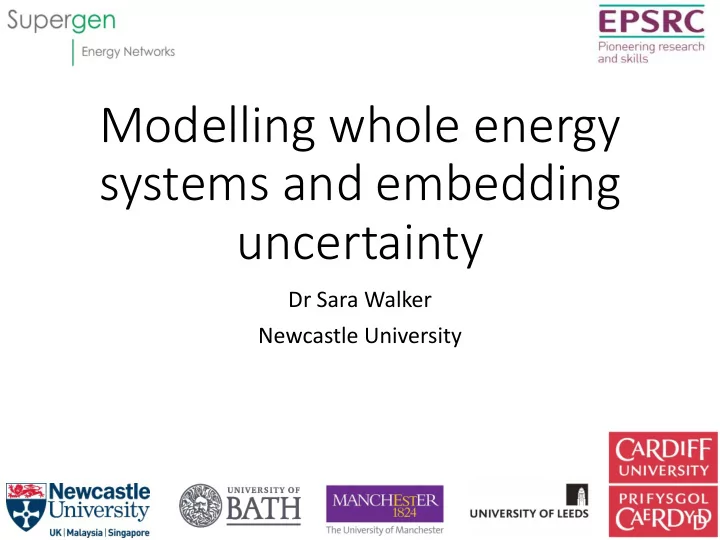

Modelling whole energy systems and embedding uncertainty Dr Sara Walker Newcastle University
Modelling whole energy systems • Congested Electrical Distribution Network or outage on electrical network with DG • Power to gas • Blend Hydrogen • Transport in gas network use for heat, transport or back to power where electrical network heavily loaded, EVs ? • Decarbonises both electrical and gas systems • Expensive Electro-chemical storage at limited scale • Gas network is inherently a large storage system • Explore if and how to use this ? • Dual Fuel Appliances • Demand side response options become much more exciting and realistic and less time limited
Early Output Highlights – Multi Vector Modelling Electricity Gas distribution distribution network network ELY+P2G Gas transmission network CHP Distribution networks: Base Case
Early Output Highlights – Multi Vector Modelling Electricity Gas distribution distribution network network Rather than curtail the generation, utilise to generate Hydrogen to blend into the gas network ELY+P2G Gas can be used to Fuel Vehicles Gas transmission network CHP Distribution networks: Scenario1: Fault in the electricity network
Adding uncertainty -demand
Model parameter in inputs Description Example Typical Uncertainty Heating Natural gas boiler serving a radiator central heating system Heating setpoint (setback) temperatures 19°C (16°C) 17.5°C-20.5°C Ventilation Manually operated natural ventilation (mech extract to family bathroom and ensuite) Gas boiler seasonal efficiency 65% (20 years old non-condensing gas-fired system boiler - 77°C/55°C F+R) 60% - 75% Heating schedule 02:00-11:00 & 16:00-24:00 DHW consumption 0.3 litre/m2/day Natural ventilation rate (per person) Highly stochastic, controlled by occupants via openable windows. Cooling setpoint/setback temperatures Uncontrolled 1.4 W/m 2 (manually controlled) to achieve 200 lux Nominal lighting power density 2.2 W/m2 /100 Lux Occupants 2 people in total Total small power gains [a] 6 W/m2 allowed for in overheating calculations. 3 W/m2 Fabric U-values 3mm self-cleaning glass (outer), 20mm Argon filled cavity, 3mm low emmisivity glass Glazing (with low emissivity coating) (inner). (U-Value 1.788 W/m 2 K - System total) ± 2% Glazing G Value (solar transmittance) 0.691 ± 5% External walls [b] ( W/m 2 K) 0.544 ± 15% Roof [c] (W/m 2 K) 0.213 ± 15% Floor [d] ( W/m 2 K) 0.337 ± 5% [f] Infiltration (ac/h) [e] 0.5 0.2 - 0.95 [a] Electricity (ICT and appliances) 3 W/m2; Gas (Catering): 3W/m2 [b] 100mm brickwork, 50mm Stonewool insulation, 100mm blockwork, 10mm plasterboards (EXTERNAL WALL: stonewoll insulation [c] 25mm Clay tile roofing, loft space, 180mm glass fibre quilt insulation, 10mm plasterboards ( Insulation range [ 150mm -210mm]) [d] 100mm cast concrete, 7mm screed, 4mm high gauge polythene DPM, 5mm foil underlay, 15mm solid wood flooring [Foam- [e] Empirical values derived from table 4.16 (CIBSE Guide A) for a two storey property on normally exposed site [f] non-suspended ground floors with no air cavities have much greater thermal unity (BRE Conventions for U-valuecalculations 2006 edition)
Parameter in input variation for uncertainty emulator 1000 simulations
Preliminary ry results 25000 99.3% within 3 standard deviation range. Annual Gas Consumption 20000 observed 17437 15000 0 100 200 300 400 500 Design point
Recommend
More recommend